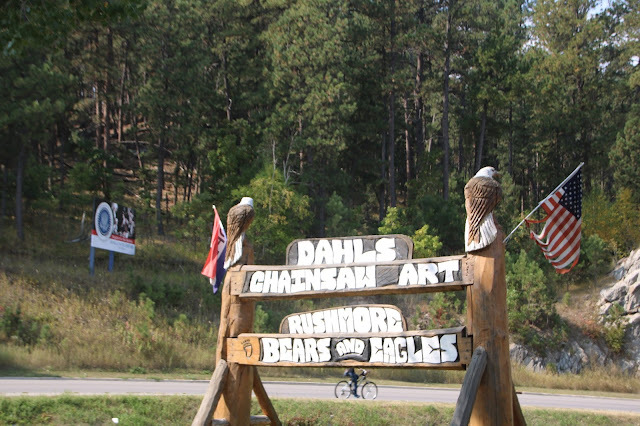Day 1 - Toronto to Chesterton IN
Day 2 - Chesterton IN to Rochester MN
Day 3 - Rochester MN to Lincoln NB
Day 4 - Lincoln NB to Denver CO
Weekly recap with more photos
September 10
It's nice not to be moving on today. But it turned out to be a busy day!
Breakfast and then Mount Rushmore. Lots of touristy stuff along the way.
As we near Mount Rushmore we are amazed we can see it from the highway.
As we are paying our entrance fee the ranger asked if we were seniors, yes, it cost us $5 for the car and it is good for a year!!
Everything is organized.
Mount Rushmore National Memorial is a sculpture carved into the granite face of Mount Rushmore, a batholith in the Black Hills in Keystone. Sculptor Gutzon Borglum created the sculpture's design and oversaw the project's execution from 1927 to 1941 with the help of his son, Lincoln Borglum. Mount Rushmore features 60-foot (18 m) sculptures of the heads of four United States presidents: George Washington(1732–1799), Thomas Jefferson (1743–1826), Theodore Roosevelt (1858–1919), and Abraham Lincoln (1809–1865). The memorial park covers 1,278.45 acres (2.00 sq mi; 5.17 km2) and is 5,725 feet (1,745 m) above sea level.
.
In the food court.
In the gift shop.
We drive into Keystone where the parking is $5 by honour system.
Keystone had its origins in 1883 as a mining town, and has since transformed itself into a resort town, serving the needs of the millions of visitors to Mount Rushmore National Memorial, which is located just beyond city limits.
The town took its name from a local mine, which most likely was named after the keystone Masonic symbol.
It is your typical tourist trap, lots of places to waste money on impulse buys. I would hate to see it in July and August!
The town took its name from a local mine, which most likely was named after the keystone Masonic symbol.
It is your typical tourist trap, lots of places to waste money on impulse buys. I would hate to see it in July and August!
Jarrett Dahl carves bears, eagles and more out of wood with their chainsaws!
We headed into Rapid City.
“Hunkayapi” or “Tying on the Eagle Plume” was created by local artist Dale Lamphere of Sturgis, South Dakota to mark the entryway of a Rapid City landmark buisness, Prairie Edge Trading Company and Galleries. The work is inspired by the Lakota naming ceremony (known as Hunkayapi or making of relatives,) a time when the ancestry of each person is remembered, a new name is given, and future relations are celebrated.
The sculpture depicts an elder Lakota woman, an unci (grandmother,) adding the first eagle plume to the hair of a young girl as she is being prepared for the ceremony. The grandmother wears a traditional cowry shell dress covered with a buffalo robe; the young girl wears a traditional buckskin dress and is also wrapped in a buffalo robe.
The work signifies the importance of women in Lakota culture and the wisdom, dignity, and pride that Native people carry forward through their their traditions and ceremonies.
Lunch at the Firehouse Brewery, I had shown their highway ads yesterday.
And a mural!
Time to explore.
We find Art Alley.
We stepped into the lobby of the Alex Johnson Hotel, now a Hilton.
The hotel was built by its namesake, Alex Carlton Johnson, Vice President of the Chicago & North Western Railroad. Construction began on August 19, 1927, just one day before work began on nearby Mount Rushmore and the hotel opened on July 1, 1928 and was officially dedicated on August 11, 1928.
The Alex Johnson has become so well known for reported hauntings that the SyFy Channel’s hit show “Ghost Hunters” traveled to Rapid City to do a special segment on the hotel.
The investigators reported that they experienced significant paranormal activity throughout the hotel.
Read the episode recap here.
Rapid City is known as the City of Presidents. We had a lot of fun walking the blocks between Main and Joseph to track them down.
Standing or seated on busy street corners downtown, life-sized bronze statues of 42 U.S. Presidents surprise pedestrians and motorists. The City of Presidents project is an artistic approach to economic development conceived by Rapid City businessman Don Perdue and is 100% privately financed. It’s a collaboration of U.S. history, American patriotism, public sculpture and national pride.
Here's a sample.
John managed to get three of them on this block.
| MITAKUYE OYASIN (we are all related) Takuwan kakanpi kile maḱa sitomni wicaśa tuweke eyaś ohokicilapi kte, na ob ocinwaśteya onpi kte, na igluonihanpi kte. Maḱa kile cangleśka selececa heun he iyacinpi. Cannumpa kaicic'uya kihe Maḱa owancaya wowah'wala kte, na Wanbli Oyate ki inś wocekiye hoyeyapi ki hena napeiyuze, na wah'upa koze ki hena iyacinpi. Mat'o ji he woksape ki hena yuha, na wapiyapi kena yuha, na Keya ki he wiconi hanske kihe iyacinpi. Tátánka kihe inś wiconi wan waśte ca onk'upi, akih'anpi cola, na nakun Winyan Wakan wan ptehincala cannumpa wan onk'upi. Ho, Mitakuye Oyas'in.
|
| MITAKUYE OYASIN (we are all related) This sculpture represents hope for reconciliation, dignity and respect for all the human race. The earth itself is in the shape of a hoop or circle of life. The crossed pipes represent world peace. The eagle symbolizes all flying creatures, and communication with Tunka Śila. Wisdom and the healing arts are represented by the grizzly bear, and a long and productive life is symbolized by the turtle. The bison reminds us of our ancestors' healthy lifestyles, free from famine, and also of the White Buffalo Calf Woman who brought us the pipe.
|







































































Thanks for translating the verbiage below the Indian Head.
ReplyDeleteThere's a lot of art in Rapid City!
ReplyDeleteI have only been to Rushmore once as a child, but it made quite an impression on me.